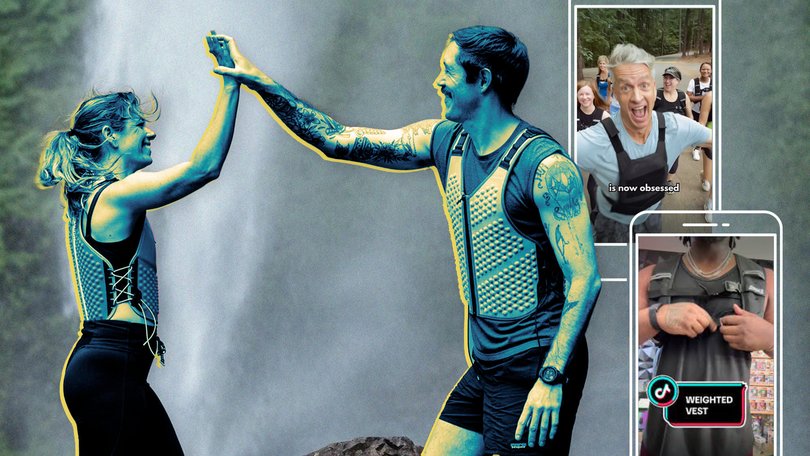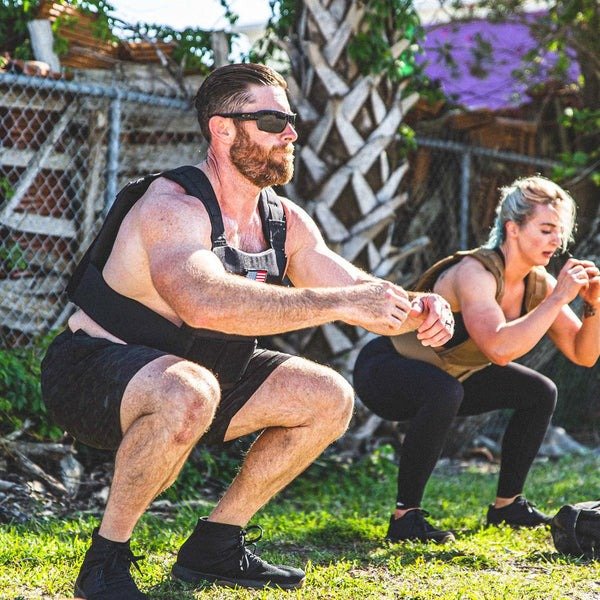THE WASHINGTON POST: The long, strange journey of the weighted vest

Like multitudes of middle-class American suburbanites have in recent months, Kim Holderness looked out her window in Raleigh, North Carolina, earlier this year and chuckled at what she saw: “Just a parade of middle-aged men and women wearing weighted vests walking by. Almost like an army,” Holderness, 49, remembers. “I was like, ‘Holy s---. It’s not just me.’”
Unlike all those multitudes, she promptly sat down with her husband, Penn Holderness, and got to work writing and choreographing a song and dance number about it to the tune of the Beauty and the Beast set piece Be Our Guest.
Two months later, the Weighted Vest video by the Holderness Family - enthusiastically performed by Penn, the couple’s neighbours and Kim’s friends from a recreational adult dance class - has been viewed more than 6 million times. “It took us less than two hours to gather these people,” Penn says, “because, literally, they said, ‘Well, if I wasn’t here, I would be walking around in my weighted vest.’”
Sign up to The Nightly's newsletters.
Get the first look at the digital newspaper, curated daily stories and breaking headlines delivered to your inbox.
By continuing you agree to our Terms and Privacy Policy.For the Holdernesses, both full-time content creators, their weighted vest videos garnered what they describe as “above-average” engagement (another video hit 12 million views).
It doesn’t take much to grasp why they resonated. Searching for “weighted vest” on TikTok or Instagram summons an avalanche of reviews, tutorials, testimonials and memes.
Leading weighted-vest brands have reported substantial sales increases: The Texas-based brand Hyperwear reported a 60 percent bump in sales of its popular weighted vests from 2024 and a nearly 140 percent increase since 2023. The Portland-based, Nike-alum-founded Omorpho has seen sales of its G-Vest model double every year since it launched in 2021.
In the workout world, it has undoubtedly been the year of the weighted vest. These once-specialised devices have taken a long, strange journey - from military boot camps to actors’ superhero movie training regimens to mall-walking moms and grandmas in the suburbs. As so many once-specialised things do in the social media age, they’ve escaped the containment of their original context.
The workout that invented workouts
It would be tough to say when exactly humans started strapping weight to their torsos for exercise; the practice of doing so predates the concept of exercise itself.
“We got carrying devices from mothers who got creative millions of years ago and needed to figure out a way to carry their kids. Because before you’d have to hand-carry a kid,” says Michael Easter, a health journalist and the author of the 2021 book The Comfort Crisis, about the health benefits of defining and then exceeding your so-called comfort zone.
Freeing up adults’ hands and the energy it otherwise took to keep track of children, adults’ productivity went “through the roof,” and “really sort of pushed human evolution,” Mr Easter says. “From there, we were obviously like, ‘Well, turns out we could carry other stuff in these things.’”
What is fairly well understood about the origins of weighted walking for exercise is that militaries have required soldiers to do it for centuries - though it’s more commonly called “rucking” in armed-forces circles.
“It came out of this term ‘rucksack,’ which was basically terminology in Germany in the 1800s for a backpack or a pack used for outdoor ventures,” Mr Easter says. The term eventually made its way to the military, where the practice of rucksack-marching to build strength and endurance was shortened to rucking.
In the 2010s and early 2020s, rucking and its accompanying weighted gear had a breakout moment among fitness-minded civilians.
Some, like Dirk Buikema, the founder and CEO of Hyperwear, cite returning Afghanistan and Iraq veterans who brought their tactical plate carrier workouts home - and to their CrossFit gyms.
And it would be foolish to ignore the influence of a flurry of magazine features in the mid-2010s in which trainers described using weighted vests to get actors like Chris Pratt and Emily Blunt into shape to play action heroes.
But many point to Mr Easter himself, and a section of The Comfort Crisis about rucking, as the genesis of the civilian fascination with weighted walking. The book arrived, after all, during the COVID pandemic, when Americans were desperate for low-risk, low-overhead exercise activities that could be performed in the social-distance-friendly outdoors.
Organizations like GoRuck - a Florida-based rucking club that has been hosting group events and athletic competitions across the US and internationally since 2008 - were waiting for them.
“It just really started to take off right around then. I’ve met men and women, young and old, who have told me that (the pandemic) is where they first started to really connect the dots,” says its co-founder Emily McCarthy.
“And since then, there have been people telling me, like, ‘Oh! My neighbours in the Hamptons are rucking right now!’” she adds with a laugh. (GoRuck’s own Training Weight Vest saw a 135 percent increase in sales from 2023 to 2024, and an additional increase in the first eight months of 2025.)

Whether rucking and weighted-vest walking are interchangeable terms is, admittedly, still a linguistic negotiation.
Since some conceive of rucking to specifically refer to long-distance walking while wearing a vest that carries weight plates - not to mention a slightly more tactical, rugged aesthetic than the squishy ones in the Holderness Family videos - Easter says he’s started referring to both as “weighted walking”.
“But I do see people saying they’re rucking with a weight vest too, just as the term has become more popular,” he adds. “We’re kind of in the process of figuring out terms.”
From the Middle Ages to middle age
Over the past year, though, a word has entered the conversation that likely hadn’t been uttered in the same breath as “rucking” much before: menopause.
Influencers such as Kymberly Chase (known on TikTok as KymFabOver40) and the OB-GYN-turned-menopause-influencer Mary Claire Haver, among others, helped fuel chatter about weighted walking as a prevention tool for the metabolic slowdown and bone-density loss associated with menopause.
The former has attributed a 13kg weight loss to her weighted vest; the latter touts “Stronger bones, better balance, increased strength, support for metabolic health” among the benefits.
Recent research has questioned whether weighted vests are truly an antidote to bone-density loss. Jaclyn McKenna, a primary sports medicine physician at the orthopaedics-specialising Hospital for Special Surgery, says it certainly could help: “By adding load, you burn more energy, recruit more muscle fibres, and place greater stress on your bones and joints.
This can help slow bone loss and reduce fall risk as we age,” she wrote in an email. But the evidence for other touted benefits of weighted vests, she cautions, like improved core strength and brain health, is limited.
The interest among nonmilitary civilian women - especially those who might be wearing one with an iPhone in one hand and a Stanley cup in the other - has of course made its own impression on how the general public conceives of weighted vests.
The appetite for a smoother, cuter, more Lululemon-inspired silhouette has created a cottage industry of inexpensive but sleek-looking weight vests; many are sold by an assortment of knockoffs through Amazon and Target and look nearly identical across brands.
This influx of yoga moms and walking-the-dog dads adopting and adapting a strength-training apparatus beloved by CrossFit types - and rebranding it as an ageing-friendly workout - has earned the occasional side-eye.
“I’ve definitely seen some people make snide remarks. Among the people who were doing it before it became popular, there’s probably some pushback. But that’s just how it goes,” Mr Easter says. “It’s the phenomenon of, like, ‘This place was cool until the person who got here right after me got here’.”
Ms McCarthy, though, has witnessed moments of good-faith inclusion. At an event in St Louis recently, a women’s rucking group was celebrating its 10th anniversary with a weekend of rucking challenges and team events.
“These are very hardcore, awesome women,” Ms McCarthy says, many of whom have been rucking together for years. And this year, they were more than happy to welcome a crop of newcomers, she says - all in athleisure-style weighted vests.
© 2025 , The Washington Post
